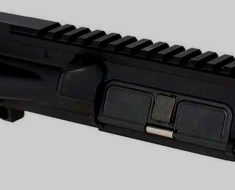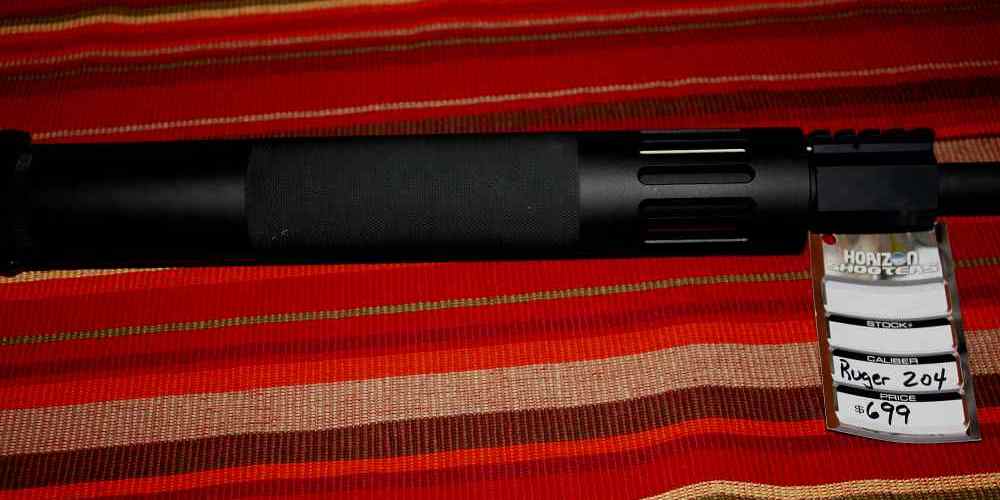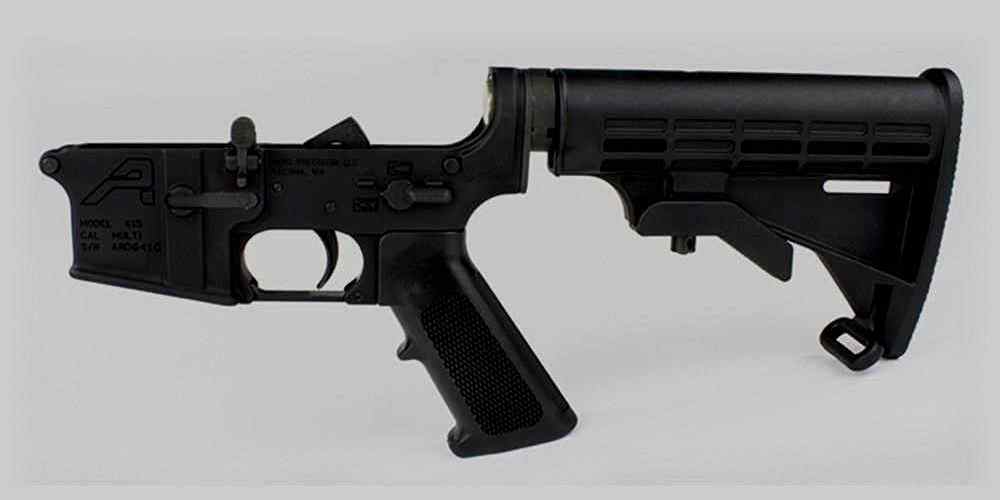“Mastering the AR15 Upper Receiver: Troubleshooting Made Easy”
Proper Cleaning and Maintenance Techniques for AR15 Upper Receivers
The AR15 is a popular and versatile firearm that is known for its reliability and accuracy. However, like any mechanical device, it can experience issues from time to time. One of the most common areas where problems can arise is with the upper receiver. Proper cleaning and maintenance of the upper receiver is essential to ensure that your AR15 functions properly and reliably. When it comes to cleaning your AR15 upper receiver, there are a few key steps that you should follow. First, make sure that the firearm is unloaded and the magazine is removed. Next, separate the upper and lower receivers by pushing out the takedown pin and pivot pin. Once the upper receiver is removed, you can begin the cleaning process. Start by using a bore brush and solvent to clean the barrel of the upper receiver. Make sure to scrub thoroughly to remove any fouling or debris. Next, use a cleaning rod and patches to clean the chamber and bore. Be sure to use a solvent that is specifically designed for firearms to ensure that you do not damage the metal. After cleaning the barrel, move on to the bolt carrier group. Remove the bolt carrier group from the upper receiver and disassemble it. Clean each component thoroughly with solvent and a brush, paying special attention to the bolt face and gas rings. Once the bolt carrier group is clean, reassemble it and lubricate it with a high-quality gun oil. Finally, clean the upper receiver itself. Use a brush and solvent to clean the inside of the upper receiver, paying special attention to the feed ramps and locking lugs. Once the upper receiver is clean, wipe it down with a clean cloth and apply a light coat of gun oil to prevent rust and corrosion. In addition to regular cleaning, it is important to perform routine maintenance on your ar15 upper receiver. This includes checking for wear and tear on components such as the gas tube, gas block, and handguard. If you notice any signs of wear, it is important to replace these parts to ensure that your AR15 functions properly. Another common issue that can arise with AR15 upper receivers is a failure to feed or eject properly. This can be caused by a variety of factors, including a dirty or damaged magazine, a worn extractor, or an improperly lubricated bolt carrier group. If you are experiencing feeding or ejection issues, start by checking the magazine for dirt or debris. If the magazine is clean, inspect the extractor for wear and replace it if necessary. Finally, make sure that the bolt carrier group is properly lubricated to ensure smooth operation. If you are still experiencing issues with your AR15 upper receiver, it may be necessary to seek the help of a professional gunsmith. They will be able to diagnose the problem and make any necessary repairs to get your AR15 back in working order. In conclusion, proper cleaning and maintenance of your AR15 upper receiver is essential to ensure that your firearm functions reliably. By following the steps outlined in this article, you can keep your AR15 in top condition and avoid common issues that can arise with the upper receiver. Remember to regularly clean and inspect your AR15 to keep it functioning properly for years to come.
Identifying and Fixing Malfunctions in AR15 Upper Receivers
The AR15 is a popular and versatile firearm that is known for its reliability and ease of customization. However, like any mechanical device, it can experience malfunctions from time to time. One of the most common areas where issues can arise is in the upper receiver. In this article, we will discuss some common problems that can occur with AR15 upper receivers and how to troubleshoot and fix them. One of the most common issues that shooters may encounter with their AR15 upper receiver is failure to feed or eject properly. This can be caused by a variety of factors, including dirty or damaged magazines, improper lubrication, or a worn or damaged bolt carrier group. To troubleshoot this issue, start by checking the magazine for any dirt or debris that may be causing feeding issues. If the magazine is clean, try lubricating the bolt carrier group and checking for any signs of wear or damage. If the problem persists, it may be necessary to replace the bolt carrier group or seek professional assistance. Another common issue that can occur with AR15 upper receivers is failure to cycle properly. This can manifest as a failure to chamber a round, failure to extract a spent casing, or failure to lock back on an empty magazine. To troubleshoot this issue, start by checking the gas system for any blockages or leaks. If the gas system is functioning properly, check the buffer spring and buffer tube for any signs of wear or damage. If the issue persists, it may be necessary to replace these components or seek professional assistance. One of the most frustrating issues that shooters may encounter with their AR15 upper receiver is a loose or wobbly handguard. This can be caused by improper installation, worn or damaged mounting hardware, or a misaligned gas block. To troubleshoot this issue, start by checking the mounting hardware for any signs of wear or damage. If the mounting hardware is in good condition, try re-installing the handguard to ensure that it is properly aligned. If the issue persists, it may be necessary to replace the mounting hardware or seek professional assistance. In conclusion, while the AR15 is a reliable and versatile firearm, it can experience malfunctions from time to time. By understanding some common issues that can occur with AR15 upper receivers and how to troubleshoot and fix them, shooters can ensure that their firearm remains in top working condition. Remember to always follow proper maintenance procedures and seek professional assistance if needed. With a little bit of knowledge and some troubleshooting skills, shooters can keep their AR15 running smoothly for years to come.
Upgrading and Customizing AR15 Upper Receivers for Improved Performance
If you’re a gun enthusiast or a seasoned shooter, chances are you’ve come across issues with your AR15 upper receiver at some point. Whether it’s a failure to feed, a jammed bolt, or inconsistent accuracy, these common problems can be frustrating to deal with. However, with a little troubleshooting and some basic knowledge of how your AR15 upper receiver works, you can easily diagnose and fix these issues to get your rifle back in top shape. One of the most common issues with AR15 upper receivers is failure to feed. This can be caused by a variety of factors, including dirty or damaged magazines, improper ammunition, or a worn-out bolt catch. To troubleshoot this issue, start by checking your magazines for any dirt, debris, or damage. Clean them thoroughly and make sure they are properly seated in the magazine well. Next, inspect your ammunition to ensure it is the correct caliber and in good condition. If the issue persists, consider replacing your bolt catch, as a worn-out catch can prevent the bolt from locking back after firing. Another common issue with AR15 upper receivers is a jammed bolt. This can occur when the bolt carrier group becomes dirty or when the gas system is not properly tuned. To troubleshoot this issue, start by cleaning your bolt carrier group thoroughly with a solvent and a brush. Pay close attention to the gas rings, as they can become clogged with carbon buildup. Next, check your gas system for any leaks or blockages. Make sure your gas block is properly aligned and that your gas tube is free of obstructions. If the issue persists, consider adjusting your gas system to ensure proper cycling. Inconsistent accuracy is another common issue with AR15 upper receivers. This can be caused by a variety of factors, including a loose barrel nut, improper barrel alignment, or a worn-out barrel. To troubleshoot this issue, start by checking your barrel nut for proper torque. Use a torque wrench to tighten the nut to the manufacturer’s specifications. Next, inspect your barrel for any signs of wear or damage. If your barrel is worn out, consider replacing it with a new one. Finally, check your barrel alignment to ensure it is properly seated in the upper receiver. If the issue persists, consider upgrading your barrel to improve accuracy. In conclusion, troubleshooting common issues with AR15 upper receivers can be a straightforward process if you have a basic understanding of how your rifle works. By following these simple steps and paying attention to detail, you can easily diagnose and fix issues such as failure to feed, jammed bolts, and inconsistent accuracy. Remember to always follow proper safety procedures when working on your rifle and consult a professional gunsmith if you are unsure of how to proceed. With a little patience and know-how, you can keep your AR15 upper receiver running smoothly for years to come.
Troubleshooting Accuracy and Precision Issues with AR15 Upper Receivers
If you’re experiencing accuracy and precision issues with your AR15 upper receiver, don’t worry – you’re not alone. Many shooters encounter these problems at some point, but the good news is that they can often be easily resolved with a bit of troubleshooting. In this article, we’ll discuss some common issues that can affect the accuracy and precision of your AR15 upper receiver, as well as some tips on how to fix them. One of the most common issues that can affect the accuracy of your AR15 upper receiver is a loose barrel. If your barrel isn’t properly secured to the upper receiver, it can move around during firing, causing your shots to be inconsistent. To fix this issue, make sure that your barrel is properly torqued to the upper receiver according to the manufacturer’s specifications. You may also want to check the barrel nut to ensure that it is tightened securely. Another common issue that can affect accuracy is a dirty or fouled barrel. If your barrel is clogged with carbon buildup or other debris, it can affect the trajectory of your bullets and cause them to stray off target. To fix this issue, make sure to clean your barrel regularly using a cleaning rod and solvent. You may also want to consider using a bore snake or other cleaning tool to remove any stubborn fouling. In addition to barrel issues, problems with your optics can also affect the accuracy of your AR15 upper receiver. If your scope or red dot sight is not properly zeroed, your shots may not hit where you’re aiming. To fix this issue, make sure to zero your optics properly using a boresighter or by shooting at a target at a known distance. You may also want to check the mounting hardware for your optics to ensure that they are securely attached to your upper receiver. Another common issue that can affect precision is a loose or improperly installed gas block. If your gas block is not properly aligned with your barrel, it can affect the gas flow to your bolt carrier group and cause malfunctions. To fix this issue, make sure that your gas block is properly aligned and secured to your barrel using the appropriate tools. You may also want to check the gas tube to ensure that it is properly seated in the gas block. Finally, issues with your ammunition can also affect the accuracy and precision of your AR15 upper receiver. If you’re using low-quality or inconsistent ammunition, your shots may not group tightly or hit where you’re aiming. To fix this issue, make sure to use high-quality, consistent ammunition that is appropriate for your rifle. You may also want to experiment with different bullet weights and brands to find the best match for your rifle. In conclusion, accuracy and precision issues with your AR15 upper receiver can be frustrating, but they are often easily resolved with a bit of troubleshooting. By checking for common issues such as loose barrels, dirty barrels, misaligned optics, loose gas blocks, and poor ammunition, you can improve the performance of your rifle and enjoy more consistent shooting. If you’re still experiencing issues after trying these troubleshooting tips, don’t hesitate to seek help from a qualified gunsmith or firearms expert. With a bit of patience and attention to detail, you can get your AR15 upper receiver shooting straight and true once again.
Addressing Compatibility Problems with AR15 Upper Receiver Components
If you’re a gun enthusiast or a seasoned shooter, you probably know that the AR15 is one of the most popular rifles in the United States. However, like any piece of machinery, it can sometimes encounter issues that need troubleshooting. One common area where problems can arise is with the upper receiver of the AR15. In this article, we’ll address some of the compatibility problems that can occur with AR15 upper receiver components and provide some tips on how to troubleshoot them. One of the most common issues that shooters encounter with AR15 upper receivers is compatibility problems with different components. This can happen when trying to mix and match parts from different manufacturers or when using aftermarket accessories. For example, if you try to install a handguard that is not compatible with your upper receiver, you may find that it doesn’t fit properly or that it interferes with other components. To troubleshoot compatibility issues with AR15 upper receiver components, it’s important to first identify the source of the problem. Start by checking the specifications of the parts you are trying to install and compare them to the specifications of your upper receiver. Look for any discrepancies in dimensions or mounting systems that could be causing the compatibility issue. If you determine that the components are indeed incompatible, you may need to either replace the parts with ones that are compatible or make modifications to ensure a proper fit. This could involve filing down certain areas, drilling new holes, or using adapters to bridge the gap between components. Another common issue that shooters encounter with AR15 upper receivers is problems with the gas system. The gas system is a critical component of the AR15 that regulates the flow of gas from the barrel to cycle the action. If there are issues with the gas system, you may experience malfunctions such as failure to eject or failure to feed. To troubleshoot gas system issues with AR15 upper receivers, start by checking for any leaks or blockages in the gas tube or gas block. Make sure that all components are properly aligned and tightened to prevent gas from escaping. If you suspect that there may be a problem with the gas system, it’s best to consult with a qualified gunsmith or armorer for further diagnosis and repair. In addition to compatibility and gas system issues, shooters may also encounter problems with the barrel and barrel nut on AR15 upper receivers. If the barrel nut is not properly torqued or if the barrel is not properly aligned, it can affect the accuracy and reliability of the rifle. To troubleshoot barrel and barrel nut issues with AR15 upper receivers, start by checking the torque specifications for the barrel nut and ensuring that it is tightened to the correct specifications. If you suspect that the barrel is not properly aligned, you may need to disassemble the upper receiver and reassemble it while paying close attention to the alignment of the barrel. In conclusion, troubleshooting common issues with AR15 upper receivers requires a systematic approach to identify and address the root cause of the problem. By checking for compatibility issues, inspecting the gas system, and ensuring proper alignment of the barrel and barrel nut, shooters can maintain the performance and reliability of their AR15 rifles. If you encounter any issues that you are unable to resolve on your own, don’t hesitate to seek help from a qualified gunsmith or armorer for assistance.







